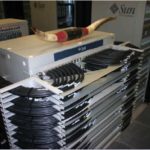In our converesation with Adrian Cockcroft, we start with Netflix’s move to the cloud, a significant event that helped put cloud computing on the map. Then it’s on to Environment, Sustainability, and Governance (ESG), Formula-1 racing, and cloud configurations and interconnects for HPC and AI workloads. And we talk about accessing the Amazon Sustainability Data Initiative (ASDI) and its petabytes of data, including weather observations, ocean temperatures, climate projection data and satellite imagery, used by researchers and scientists….
@HPCpodcast: AWS, Sun, eBay, Netflix (and Others) Vet Adrian Cockcroft Talks Cloud HPC-AI and the Amazon Sustainability Data Initiative
Legendary Magnum InfiniBand Switch comes to Computer History Museum
The Computer History Museum in Silicon Valley recently added a piece of TACC’s history into their permanent historical collection — sealing its place as a milestone in computing.
We’re always searching around the world for new, interesting, and important computing objects,” said Dag Spicer, senior curator at the Computer History Museum. “TACC’s Sun Microsystems 2007 Magnum switch was a critical part of high-performance computing at that time in history. The TACC switch was the largest of its class and is an example of InfiniBand technology, which has long been a key enabling technology for high performance computing.”
Interview: John Gustafson on the Evolution of Supercomputing
In this MacObserver podcast, John Martellaro discusses the evolution of HPC with John Gustafson, Visiting Professor at NUS in Singapore. “Known by many as the father of Gustafson’s Law, Dr. John Gustafson is a professor of computer science, now at The National University of Singapore. Listen in as John describes his career arc and offers some great advice for young scientists just getting started.”
Video: How the SPARC M7 Builds Security into Silicon
“The SPARC M7 incorporates silicon-embedded advancements primarily in two areas: security and performance. First, the SPARC M7 accelerates data encryption through “cryptographic units” integrated in each of its 32 cores. And by incorporating very high-performance encryption in the chip, Fowler says, the M7 is able to not only secure data quickly but also devote substantial processor resources to additional projects, resources that otherwise would be occupied encrypting data at the software layer.”








